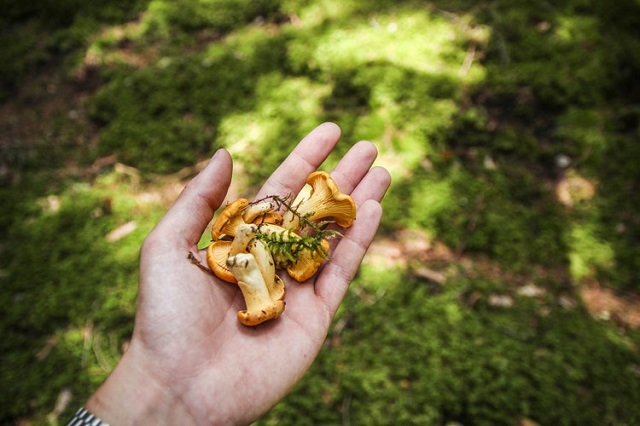
**Elephant is not your doctor or hospital. Our lawyers would say “this web site is not designed to, and should not be construed to provide medical advice, professional diagnosis, opinion or treatment to you or any other individual, and is not intended as a substitute for medical or professional care and treatment. Always consult a health professional before trying out new home therapies or changing your diet.” But we can’t afford lawyers, and you knew all that. ~ Ed.
~
A few years ago, I suffered an intense concussion while surfing in Bali.
What was supposed to be a week-long recovery period spiraled into a brutal, six-month post-concussion journey. During this time, I had to limit cognitive activity in order to let my brain heal—this meant no internet, no TV, and no music. Ultimately, I sat alone in a room for much of the recovery. These harsh conditions, alongside my brain not functioning properly, led to a plummeting of my mood.
I had constant anxiety attacks. I would go days without sleep and was hit with the worst bout of depression of my life. Ironically, managing mood is one of the foundations of concussion recovery, which meant my healing was drastically stalled during this time. For months, I put off the idea of taking antidepressants, as I held onto rigid judgements that I was being too weak or lazy to handle my problems on my own.
Over time, the depression became too much to bear, and I knew I needed help. I ended up taking 20 mg of Fluoxetine daily (better known as Prozac), which became a pivotal moment in my road to recovery. My mood lifted—and as a result, my brain started to heal. I was back on my feet within months, finally able to work, socialize, and live a normal life. I owe much of these results to the antidepressant medication.
Yet, after using Prozac for over 18 months, I ultimately decided to come off it for a number of reasons:
>> My libido became practically nonexistent.
>> At times, I felt emotionally numb.
>> It had been over a year since I healed from my concussion.
One of the biggest reasons I came off antidepressants was discovering a few alternative tools that worked just as well, yet without the negative side effects.
I’m going to share what these are—but before I dive in, it’s important to note that I’m not a medical professional, and I’m not making any specific recommendations. What works for one person may not work for another (especially when dealing with mental health). I’m simply sharing what worked for me personally, which may (or may not) show you similar results.
It’s also worth mentioning that none of these tools were magic bullets. In addition to these alternative tools to improve my mood, I also adopted several conventional methods such as healthy eating, exercise, restful sleep, socializing, and meaningful work. By combining this traditional protocol with the alternative tools mentioned below, my results really started to take off.
Transcranial Direct Current Stimulation (tDCS).
One of the more exciting mind tools that has grown in popularity the past few years is that of “transcranial direct current stimulation” (tDCS). tDCS falls under a broader category of electroceuticals, or the use of electricity to treat various physical and mental disorders. tDCS works by attaching a nine-volt battery to electrodes placed in specific areas of the scalp.
By sending a tiny electrical current to the surface of the skull, neurons of these selected areas are either less likely (or more likely) to fire, resulting in greater functioning of the target area in the brain. tDCS has been shown to help accelerate learning, enhance skill acquisition, improve sleep quality, improve working memory, and of course help with mood management. (1,2,3,4,5)
The idea of shocking the brain may seem bizarre (and dangerous), but a simple Google-scholar search for tDCS will produce thousands of studies that have explored the efficacy and safety of this alternative technology. In reality, only two milliamps are applied to the scalp, which is roughly 1/500th the amount used by a 100-watt light bulb. My experience has been practically pain-free (at worst I’ve felt slightly tingly, itchy sensation on my forehead).
After studying the research and reading through the active tDCS sub-Reddit, I purchased a tDCS device online and followed a conservative protocol of 15-minute sessions, twice weekly. To my surprise, the results were immediate. I felt better within five minutes during the session, and the results lasted for days afterward. To date, there have been no negative side effects (aside from the temporary itchy feeling mentioned earlier). Out of all the items I mention in this article, tDCS has given me the most bang for my buck. Wahoo!
Mindfulness Meditation.
Depression and anxiety are often fueled by an over-thinking, over-analyzing, and an over-active mind. By learning to quiet the mind through age-old practices such as mindfulness meditation, we can in time reduce these depressive symptoms.
Over the past decade or so, meditation has come out of the new-age closet to become a legitimate, culturally-adopted method to improve mental health. This trend has largely been due to the science backing up the practice.
John Hopkins University underwent a systematic review of over 19,000 meditation studies (filtering and hand selecting 47 studies that were the most well-designed). They concluded that mindfulness meditation can indeed help ease mental illness such as anxiety and depression. (6) Another exciting study done by Oxford University found that mindfulness-based-cognitive therapy was just as effective as medication in preventing depression relapse. (7)
Before making the decision to come off antidepressants, I practiced meditation inconsistently—a few sessions a week (at best). Yet, when I actually came off the medication, I knew I needed drum-beat like consistency to get the mental benefits from the practice. I used Insight Timer to track my sessions and made it a habit to either start (or finish) my day with a 30-minute body-scan meditation. Over a year later, with consistent practice, I can wholeheartedly say that my depression hasn’t come back because of this.
Plant Medicines.
Our culture is amidst a psychedelic renaissance of sorts. The once problem child of the ’60s is now being studied at the most respected academic institution in the world and is fast becoming a legitimate tool to aid in a range of applications. Silicon Valley engineers are using LSD to increase creativity. Army veterans are using marijuana to combat Post-Traumatic Stress Disorder (PTSD) symptoms. Millennials are heading to South America to try Ayahuasca as a modern-day rite of passage.
One of the more exciting avenues psychedelics has shown to help is improving mental health. In my own life, I’ve turned to “magic mushrooms,” which recent studies are starting to show may be a breakthrough method to treat depression.
A study by Imperial College London treated patients with psilocybin (the psychoactive chemical in “magic mushrooms”), who were unresponsive to traditional medication. (8) Patients showed reduced depressed symptoms immediately after the experience, and MRI scans showed reduced activity in the amygdala (the part of the brain responsible for fear, stress, and emotions). Many of the patients said it felt like they hit a reset button for their mind.
I can attest to the reset effect of psilocybin; at times, I felt like years of therapy was undergone in a single night—old wounds healed, inner demons faced, and self-love realized. Weeks after the session, I can still feel my mood significantly improved. I turn to psilocybin sparingly, a few times a year (at most) at home where I can get myself in a positive set and setting (with a sitter nearby).
A less common psychoactive plant I’ve also turned to is cacao. While traveling throughout Southeast Asia, I noticed in all the spiritually minded cities I stayed in, there were local cacao ceremonies. After attending one and seeing the benefits of consuming raw cacao, I was hooked.
Raw cacao—also used to make to make heavenly, mouth-watering chocolate delights—is loaded with chemicals to help with mood management. It contains Theobromine which affects mood (9), the amino-acid Tryptophan which is famous for mood-regulating abilities (10), and Anandamide known as the bliss molecule which binds to cannabinoid receptors in the brain. (11)
In certain cases, antidepressants can be a vital life jacket amidst a whirlwind of anxiety and depression ruling your life. Yet, as effective as they can be, the medication comes with its own set of side effects which may be too much to bear over the long-term.
Alternative tools such as tDCS, mindfulness meditation, and plant medicines were key in helping me come off antidepressant medication. Some of these tools are still relatively new and more research needs to be done to verify their safety and effectiveness—but after my own experimentation with them, I can personally verify their positive mood-lifting effects and minimal negative side effects.
~
References:
1. Kadosh, Roi Cohen, et al. “Modulating neuronal activity produces specific and long-lasting changes in numerical competence.” Current Biology 20.22 (2010): 2016-2020.
2. Beeli, Gian, et al. “Brain stimulation modulates driving behavior.” Behavioral and Brain Functions 4.1 (2008): 34.
3. Saebipour, Mohammad R., et al. “Slow oscillating transcranial direct current stimulation during sleep has a sleep‐stabilizing effect in chronic insomnia: a pilot study.” Journal of sleep research 24.5 (2015): 518-525.
4. Fregni, Felipe, et al. “Anodal transcranial direct current stimulation of prefrontal cortex enhances working memory.” Experimental brain research 166.1 (2005): 23-30.
5. Fagerlund, Asbjørn J., Odd A. Hansen, and Per M. Aslaksen. “Transcranial direct current stimulation as a treatment for patients with fibromyalgia: a randomized controlled trial.” Pain 156.1 (2015): 62-71.
6. Goyal, Madhav, et al. “Meditation programs for psychological stress and well-being: a systematic review and meta-analysis.” JAMA internal medicine 174.3 (2014): 357-368. APA
7. Kuyken, W., et al. “Efficacy of Mindfulness-Based Cognitive Therapy in Prevention of Depressive Relapse.” (2016).
8. Carhart-Harris, Robin L., et al. “Psilocybin for treatment-resistant depression: fMRI-measured brain mechanisms.” Scientific reports 7.1 (2017): 13187.
9. Baggott, Matthew J., et al. “Psychopharmacology of theobromine in healthy volunteers.” Psychopharmacology 228.1 (2013): 109-118. APA
10. Bertazzo, Antonella, et al. “The content of protein and non-protein (free and protein-bound) tryptophan in Theobroma cacao beans.” Food chemistry 124.1 (2011): 93-96.
11. Hurst, W. Jeffrey. “Cacao Chemistry.” Chocolate and Health. 2015. 56-66. APA
~
Relephant:
The Shushed Side Effects of Antidepressants.
Start Eliminating Depression with these 6 Strategies.
Psychedelics & “Plant Teachers”: Technologies of Transcendence in Shamanism.
~
Author: Tony Balbin
Image: Unsplash/Nico Benedickt
Editor: Yoli Ramazzina
Copy editor: Travis May








Read 0 comments and reply